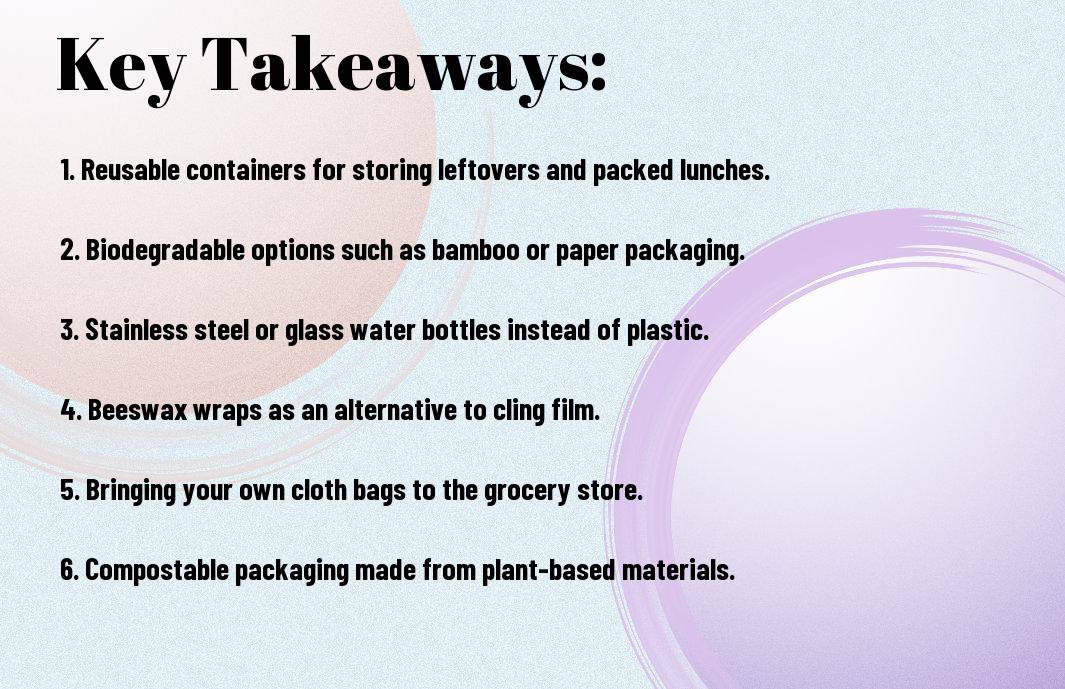Exploring ecofriendly alternatives to single-use plastic when it comes to packaging your food and drink can significantly reduce the amount of plastic waste you produce. According to a comprehensive guide by Green Matters, it is crucial to understand the environmental impact of plastic waste, especially when it comes to food and drink packaging. By making mindful choices, you can actively contribute to the reduction of plastic consumption. If you’re looking for eco-friendly alternatives to plastic packaging for your food and drink, consider implementing some of the recommendations provided in this informative guide by Green Matters Eco-Friendly Alternatives to Plastic, From Food Packaging … .
Key Takeaways:
- Biodegradable packaging: Consider using biodegradable materials such as paper, cardboard, bamboo, or cornstarch to package food and drinks. These materials break down naturally and reduce the environmental impact of single-use plastics.
- Reusable containers: Encourage the use of reusable containers made from glass, stainless steel, or silicone for packaging food and drinks. These containers can be used multiple times, reducing the need for single-use plastic packaging.
- Compostable packaging: Explore the use of compostable packaging options, such as plant-based plastics and compostable bioplastics. These materials can be disposed of in compost facilities and break down into organic matter, minimizing waste and pollution.
 I’m glad you’re looking for alternatives to single-use plastic packaging for food and drinks. In this chapter, we’ll explore biodegradable packaging and its suitability as an alternative to plastic.
I’m glad you’re looking for alternatives to single-use plastic packaging for food and drinks. In this chapter, we’ll explore biodegradable packaging and its suitability as an alternative to plastic.
Biodegradable Packaging
Biodegradable packaging is designed to break down and decompose into natural elements when it is exposed to environmental conditions like sunlight, air, and moisture. This makes it an attractive option for reducing the environmental impact of packaging waste.
Overview of Biodegradable Packaging Options
Biodegradable packaging comes in various forms, including compostable plastics, paper-based materials, and bio-based plastics. Compostable plastics are made from renewable resources and can break down into non-toxic components, while paper-based materials are often used for food packaging and can be easily recycled. Bio-based plastics are derived from renewable raw materials, offering a sustainable alternative to traditional petroleum-based plastics.
Pros and Cons of Biodegradable Packaging
| Pros | Cons |
| Reduces plastic waste | Potential for contamination if not disposed of properly |
| Derived from renewable resources | May require specific conditions to biodegrade |
| Contributes to a circular economy | Costlier than traditional plastic packaging |
| Less dependence on fossil fuels | May still release harmful substances during degradation |
When considering biodegradable packaging as an alternative to single-use plastic, it’s important to weigh the benefits and drawbacks. While it can help reduce plastic waste and fossil fuel consumption, improper disposal may lead to contamination and environmental harm. It’s essential to make sure that biodegradable packaging is disposed of in the correct manner to reap its environmental benefits. Additionally, the cost and specific conditions required for biodegradation should be taken into account when evaluating its suitability for your products.
Compostable Packaging
When it comes to finding alternatives to single-use plastic packaging for food and drink, compostable packaging is a top choice. Compostable packaging is designed to break down into natural, non-toxic components that can be absorbed by the earth, making it an environmentally friendly option. You can learn more about compostable packaging and other alternatives to plastic food & drink packaging on Toast Food’s website.
Detailed Explanation of Compostable Packaging
Compostable packaging is made from plant-based materials, such as cornstarch, sugarcane, or cellulose. These materials are designed to biodegrade, meaning they will break down into natural elements when composted. This makes compostable packaging an excellent choice for reducing your environmental impact, as it avoids the build-up of plastic waste in landfills and oceans.
Advantages and Limitations of Compostable Packaging
Compostable packaging offers several advantages, including its ability to break down naturally and reduce the overall amount of plastic waste. However, it is important to note that not all compostable packaging is suitable for home composting, and may require industrial composting facilities to break down effectively. Additionally, some compostable packaging may still release harmful substances during decomposition, so it is essential to choose certified compostable products to minimise environmental impact.
By choosing compostable packaging for your food and drink products, you can take an important step towards reducing your environmental footprint. However, it is crucial to be mindful of the specific requirements for compostable packaging and seek out certified products to ensure you are making a truly sustainable choice for the planet.
Reusable Packaging
When it comes to reducing single-use plastic packaging for food and drink, one of the best alternatives is reusable packaging. Reusable packaging can help you significantly decrease your plastic waste and contribute to a more sustainable food and drink consumption.
Description of Reusable Packaging
Reusable packaging is designed to be used multiple times, rather than being disposed of after one use like single-use plastic packaging. It can come in the form of containers, bottles, bags, and wraps made from materials such as glass, stainless steel, silicone, and fabric. These are durable, washable, and can often be used for years, making them a great long-term investment for reducing your environmental impact.
Benefits and Drawbacks of Reusable Packaging
The main benefit of reusable packaging is that it significantly reduces the amount of single-use plastic waste you generate. By using the same container or bottle multiple times, you can cut down on the need for disposable plastic packaging. However, one of the drawbacks of reusable packaging is that it may require a little more effort on your part. You will need to wash and care for the reusable items to keep them in good condition, and you may need to carry them with you when you’re out and about. Despite this, the positive impact on the environment far outweighs these minor inconveniences.
Conclusion
Upon reflecting on the best alternatives to single-use plastic packaging for food and drink, you have discovered a variety of sustainable options that can help reduce your environmental impact. By opting for reusable containers, compostable packaging, or products with minimal packaging, you can contribute to a greener, more eco-friendly future. It is important to remain conscious of the materials you use and to make informed choices that benefit both the planet and future generations.
FAQ
Q: What are the best alternatives to single-use plastic packaging for food and drink?
A: The best alternatives to single-use plastic packaging for food and drink are materials that are reusable, recyclable, or compostable. Some examples include glass, metal, paper, and biodegradable plastics.
Q: How does glass compare to single-use plastic for packaging food and drink?
A: Glass is a highly sustainable option for packaging food and drink as it is infinitely recyclable and does not leach harmful chemicals into the contents. However, it is heavier and more prone to breakage compared to plastic.
Q: Are there any eco-friendly alternatives to plastic bottles for beverages?
A: Yes, there are several options available such as stainless steel bottles, aluminum cans, and tetra-pak cartons. These materials are all recyclable and have a lower environmental impact compared to single-use plastic bottles.
Q: What are some sustainable packaging options for takeaway food?
A: Sustainable packaging options for takeaway food include compostable containers made from plant-based materials, recycled paper or cardboard containers, and reusable containers that customers can return for a deposit.
Q: Are biodegradable plastics a good alternative to single-use plastic packaging?
A: While biodegradable plastics can offer some benefits, they require specific conditions to break down properly and may not be suitable for all waste management systems. It’s important to consider the end-of-life disposal of biodegradable plastics to ensure they are actually more sustainable than traditional plastics.

